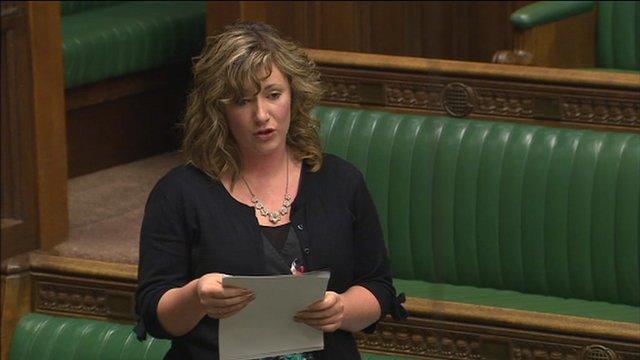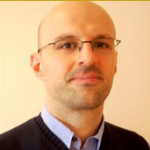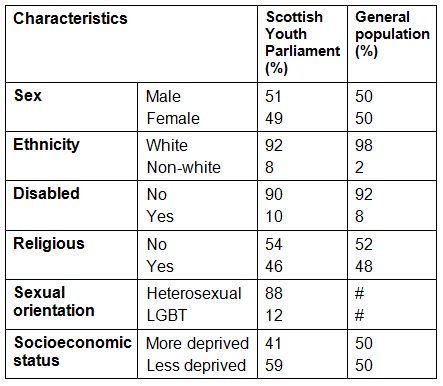The democratic potential of youth assemblies and political forums in the UK: a case study of the Scottish Youth Parliament
Young people are represented in a number of youth parliaments and assemblies in the UK, with these bodies also providing a valuable source of political experience. Stratos Patrikios and Mark Shephard have studied the Scottish Youth Parliament in detail to assess how representative the institution is. They found that it does broadly reflect the Scottish population, although there is evidence that the institution reproduces existing inequalities between social groups when it comes to the future activities of its members.

Pamela Nash was elected as a Labour MP after serving in the Scottish Youth Parliament from 2007 to 2009. Credit: BBC
Youth parliaments and assemblies are virtually omnipresent in Europe, and are certainly present in most parts of the UK. Some have even called for them to be allowed to initiate a people’s ballot or referendum (see chapter by Gerry Stoker). It is surprising, therefore, that youth parliaments and other types of similar forums have remained largely unexamined. We have explored the comparative operations of youth parliaments in Europe in the past, but the main limitation of that research was the lack of individual-level data of the experiences and characteristics of youths themselves.
In our more recent work, we take a close look at former members of the Scottish Youth Parliament (SYP). The SYP is a youth engagement, non-profit organisation established in 1999 for young people between the ages of 14 and 25. Each parliamentary intake comprises approximately 150 Members of the Scottish Youth Parliament (MSYPs). The number of constituencies mirrors that of the Scottish Parliament (73). There are typically two representatives per constituency (subject to supply). The SYP operates a quota system that makes it more likely that marginal groups will be represented. Strictly speaking there is no formal quota system in operation but connections with a diversity of affiliated groups mean that the opportunities for marginal groups to gain representation in the SYP are a built-in feature of the institution. Represented in the SYP are affiliated organisations representing specific minority groups such as the disabled, lesbian, gay, bisexual and transgendered groups, as well as other groups including the girl guides, and the YMCA and YWCA. Each of these groups is usually allocated between one and two representatives. The SYP meets at least three times a year at national meetings across Scotland including at least one meeting at the Scottish Parliament every two years.
We ask two specific questions about the Scottish Youth Parliament. First, is its membership actually representative of the various socioeconomic groups that compose Scottish society as a whole? Second, does participation in the youth parliament increase political interest, personal and skills development, and the likelihood of volunteering? In the case of the SYP information is available that allows us to answer these questions in the form of a survey conducted by its organisers in 2011 among former Members. Contact was made with 426 former members. From those contacted, 102 responded. Former members of the youth parliament were asked a number of questions about their background characteristics. They were also asked a set of questions on their experiences during and after their tenure as MSYPs.
We focus on the SYP for a number of additional reasons. Not only does it include one of the widest age ranges compared to other youth forums (14-25), but it also operates elections, and at two years, has the longest terms of office, although recruitment practices vary by local authority. Moreover, the SYP has been quite proactive in recent years, from the shadowing of national politicians, to engagement with the Scottish Parliament through focused campaigns, consultations and the submission of petitions. A small minority of former MSYPs have also continued with political careers, mainly at the local level, although former MSYP Pamela Nash was elected to the House of Commons in 2010.
We find that the membership of the youth parliament is fairly representative of Scotland on a number of socioeconomic indicators (Table 1). In some instances, however, it is over-representative of disadvantaged social groups (non-whites). In others, it is over-representative of more privileged groups (those from less deprived neighbourhoods). In any case, the composition of the SYP and that of the general population are not too dissimilar.
Table 1: Representativeness of Scottish Youth Parliament compared to general Scottish population
Source: Scottish Youth Parliament data based on responses to 2011 Former Member Survey (N=102). Population data are from a variety of sources (see article for full details). # represents unreliable data.
Further, we also find that participants to the SYP survey report that personal and skills development has been high. In addition, an overwhelming majority perceive positive impacts from their experiences as members of the assembly. However, volunteer activities, although higher among former members than in the general population, seem to be disproportionately favoured by certain social groups within the SYP – the same ones that have an associational advantage in the population at large. Our interpretation here is that the SYP may not be doing a very good job eliminating the disadvantage of certain groups in associational life: male, older, disabled and participants from more deprived socioeconomic backgrounds.
The organisers of the Scottish Youth Parliament are aware of these inequalities in volunteer activities documented here. Therefore, apart from contributing to a largely overlooked topic, our analysis also serves to identify clear target groups that organisers should assist in engaging with associational life.
—
Note: This post represents the views of the authors and does not give the position of Democratic Audit or the LSE. Please read our comments policy before responding. Shortlink for this post: buff.ly/1fp4dZ4
—
 |
Stratos Patrikios is a Lecturer in Political Science at the School of Government and Public Policy, University of Strathclyde, Glasgow. |
 |
Mark Shephard is a Senior Lecturer in Political Science at the School of Government and Public Policy, University of Strathclyde, Glasgow. |






 Democratic Audit's core funding is provided by the Joseph Rowntree Charitable Trust. Additional funding is provided by the London School of Economics.
Democratic Audit's core funding is provided by the Joseph Rowntree Charitable Trust. Additional funding is provided by the London School of Economics.
Democratic potential of youth assemblies and political forums in the UK: a case study of the @officialsyp https://t.co/gNzS8h93lr
Stratos Patrikios and @shephard_mark of @unistrathclyde on the representativeness and impact of youth parliaments https://t.co/2gTiDXoPAj
The democratic potential of youth assemblies and political forums in the UK: a case study of the Scottish Youth Parl https://t.co/BI477mpl6Y
The democratic potential of youth assemblies and political forums in the UK: a case study of the Scottish Youth … https://t.co/8KdSBN3Gm2
The democratic potential of youth assemblies and political forums in the UK: case of the Scottish Youth Parliament https://t.co/0Hy9QbprpC
The democratic potential of youth assemblies and political forums in the UK: a case study of the Scottish… https://t.co/mE93MrFI0R